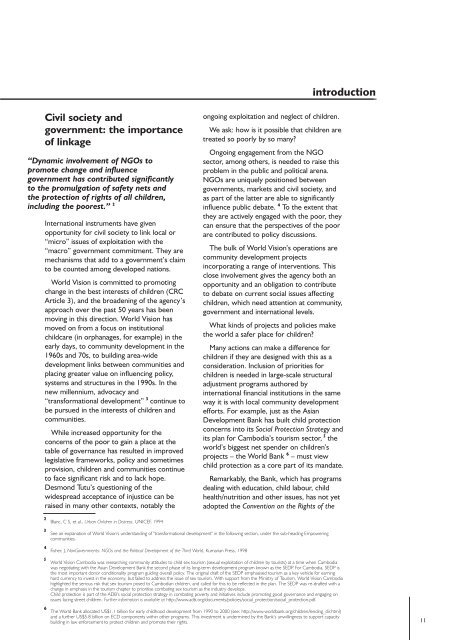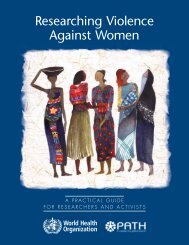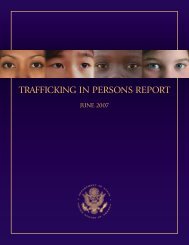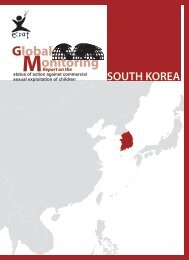Download PDF - Violence Against Children - East Asia and the ...
Download PDF - Violence Against Children - East Asia and the ...
Download PDF - Violence Against Children - East Asia and the ...
Create successful ePaper yourself
Turn your PDF publications into a flip-book with our unique Google optimized e-Paper software.
introduction<br />
Civil society <strong>and</strong><br />
government: <strong>the</strong> importance<br />
of linkage<br />
“Dynamic involvement of NGOs to<br />
promote change <strong>and</strong> influence<br />
government has contributed significantly<br />
to <strong>the</strong> promulgation of safety nets <strong>and</strong><br />
<strong>the</strong> protection of rights of all children,<br />
including <strong>the</strong> poorest.” 2<br />
International instruments have given<br />
opportunity for civil society to link local or<br />
“micro” issues of exploitation with <strong>the</strong><br />
“macro” government commitment. They are<br />
mechanisms that add to a government’s claim<br />
to be counted among developed nations.<br />
World Vision is committed to promoting<br />
change in <strong>the</strong> best interests of children (CRC<br />
Article 3), <strong>and</strong> <strong>the</strong> broadening of <strong>the</strong> agency’s<br />
approach over <strong>the</strong> past 50 years has been<br />
moving in this direction. World Vision has<br />
moved on from a focus on institutional<br />
childcare (in orphanages, for example) in <strong>the</strong><br />
early days, to community development in <strong>the</strong><br />
1960s <strong>and</strong> 70s, to building area-wide<br />
development links between communities <strong>and</strong><br />
placing greater value on influencing policy,<br />
systems <strong>and</strong> structures in <strong>the</strong> 1990s. In <strong>the</strong><br />
new millennium, advocacy <strong>and</strong><br />
“transformational development” 3 continue to<br />
be pursued in <strong>the</strong> interests of children <strong>and</strong><br />
communities.<br />
While increased opportunity for <strong>the</strong><br />
concerns of <strong>the</strong> poor to gain a place at <strong>the</strong><br />
table of governance has resulted in improved<br />
legislative frameworks, policy <strong>and</strong> sometimes<br />
provision, children <strong>and</strong> communities continue<br />
to face significant risk <strong>and</strong> to lack hope.<br />
Desmond Tutu’s questioning of <strong>the</strong><br />
widespread acceptance of injustice can be<br />
raised in many o<strong>the</strong>r contexts, notably <strong>the</strong><br />
ongoing exploitation <strong>and</strong> neglect of children.<br />
We ask: how is it possible that children are<br />
treated so poorly by so many?<br />
Ongoing engagement from <strong>the</strong> NGO<br />
sector, among o<strong>the</strong>rs, is needed to raise this<br />
problem in <strong>the</strong> public <strong>and</strong> political arena.<br />
NGOs are uniquely positioned between<br />
governments, markets <strong>and</strong> civil society, <strong>and</strong><br />
as part of <strong>the</strong> latter are able to significantly<br />
influence public debate. 4 To <strong>the</strong> extent that<br />
<strong>the</strong>y are actively engaged with <strong>the</strong> poor, <strong>the</strong>y<br />
can ensure that <strong>the</strong> perspectives of <strong>the</strong> poor<br />
are contributed to policy discussions.<br />
The bulk of World Vision’s operations are<br />
community development projects<br />
incorporating a range of interventions. This<br />
close involvement gives <strong>the</strong> agency both an<br />
opportunity <strong>and</strong> an obligation to contribute<br />
to debate on current social issues affecting<br />
children, which need attention at community,<br />
government <strong>and</strong> international levels.<br />
What kinds of projects <strong>and</strong> policies make<br />
<strong>the</strong> world a safer place for children?<br />
Many actions can make a difference for<br />
children if <strong>the</strong>y are designed with this as a<br />
consideration. Inclusion of priorities for<br />
children is needed in large-scale structural<br />
adjustment programs authored by<br />
international financial institutions in <strong>the</strong> same<br />
way it is with local community development<br />
efforts. For example, just as <strong>the</strong> <strong>Asia</strong>n<br />
Development Bank has built child protection<br />
concerns into its Social Protection Strategy <strong>and</strong><br />
its plan for Cambodia’s tourism sector, 5 <strong>the</strong><br />
world’s biggest net spender on children’s<br />
projects – <strong>the</strong> World Bank 6 – must view<br />
child protection as a core part of its m<strong>and</strong>ate.<br />
Remarkably, <strong>the</strong> Bank, which has programs<br />
dealing with education, child labour, child<br />
health/nutrition <strong>and</strong> o<strong>the</strong>r issues, has not yet<br />
adopted <strong>the</strong> Convention on <strong>the</strong> Rights of <strong>the</strong><br />
2<br />
3<br />
Blanc, C S, et al., Urban <strong>Children</strong> in Distress, UNICEF, 1994<br />
See an explanation of World Vision’s underst<strong>and</strong>ing of "transformational development" in <strong>the</strong> following section, under <strong>the</strong> sub-heading Empowering<br />
communities.<br />
4 Fisher, J, NonGovernments: NGOs <strong>and</strong> <strong>the</strong> Political Development of <strong>the</strong> Third World, Kumarian Press, 1998<br />
5<br />
World Vision Cambodia was researching community attitudes to child sex tourism (sexual exploitation of children by tourists) at a time when Cambodia<br />
was negotiating with <strong>the</strong> <strong>Asia</strong>n Development Bank <strong>the</strong> second phase of its long-term development program known as <strong>the</strong> SEDP. For Cambodia, SEDP is<br />
<strong>the</strong> most important donor conditionality program guiding overall policy. The original draft of <strong>the</strong> SEDP emphasised tourism as a key vehicle for earning<br />
hard currency to invest in <strong>the</strong> economy, but failed to address <strong>the</strong> issue of sex tourism. With support from <strong>the</strong> Ministry of Tourism, World Vision Cambodia<br />
highlighted <strong>the</strong> serious risk that sex tourism posed to Cambodian children, <strong>and</strong> called for this to be reflected in <strong>the</strong> plan. The SEDP was re-drafted with a<br />
change in emphasis in <strong>the</strong> tourism chapter to prioritise combating sex tourism as <strong>the</strong> industry develops.<br />
Child protection is part of <strong>the</strong> ADB’s social protection strategy in combating poverty <strong>and</strong> initiatives include promoting good governance <strong>and</strong> engaging on<br />
issues facing street children. Fur<strong>the</strong>r information is available at http://www.adb.org/documents/policies/social_protection/social_protection.pdf.<br />
6 The World Bank allocated US$1.1 billion for early childhood development from 1990 to 2000 (see: http://www.worldbank.org/children/lending_dir.html)<br />
<strong>and</strong> a fur<strong>the</strong>r US$5.8 billion on ECD components within o<strong>the</strong>r programs. This investment is undermined by <strong>the</strong> Bank’s unwillingness to support capacity<br />
building in law enforcement to protect children <strong>and</strong> promote <strong>the</strong>ir rights.<br />
11

















